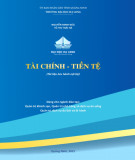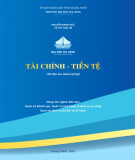
P-ISSN 1859-3585 E-ISSN 2615-9619 https://jst-haui.vn ECONOMICS - SOCIETY Vol. 60 - No. 11E (Nov 2024) HaUI Journal of Science and Technology
187
ACCESSIBILITY TO CREDIT FOR FARMERS IN RURAL AREAS: A CASE STUDY IN PHU GIAO DISTRICT, BINH DUONG PROVINCE
Nguyen Thi Thu Thuy1, Nguyen Hong Thu2,* DOI: http://doi.org/10.57001/huih5804.2024.357 ABSTRACT
Agriculture and rural area are central to Vietnam's industrialization and
modernization strategy, with credit policies playing a key role in fostering rural
economic growth. This study identies the barriers to credit access faced by
agricultural househol
ds in rural areas, focusing on Phu Giao district, Binh
Duong province. Using binary logistic regression analysis, 14 factors were
found to inuence credit access, including household characteristics (age,
gender, education, income, labor force, loan purpo
ses, technology) and
institutional factors (transaction costs and
collateral). The ndings inform
policy recommendations to enhance credit accessibility for farmers in the
region. Keywords: Credit Access, rural development, agricultural households. 1
Vietnam Bank for Agriculture and Rural Development, Phu Giao District
Branch, Binh Duong, Vietnam 2Thu Dau Mot University, Vietnam *Email: thunh@tdmu.edu.vn Received: 18/8/2024 Revised: 25/10/2024 Accepted: 28/11/2024 1. INTRODUCTION The industrialization and modernization of agriculture in Vietnam's rural areas are progressing rapidly across the country. This trend suggests that in the coming years, an inux of foreign investment and goods into Vietnam will be inevitable. However, prioritizing urban economic development without corresponding investments in rural economies could hinder the nation's broader industrialization and modernization goals. In many developed countries, the nancial system is characterized by the coexistence of both formal and informal nancial sectors. The formal nancial sector typically accounts for 30% to 80% of rural credit supply, yet access to formal credit remains limited for farmers globally - only 5% in Africa, 15% in Latin America, and 25% in Asia [8]. In Vietnam, approximately 15 million farming households constitute nearly 80% of the population, with more than half (6.7 million) classied as low-income. According to the 2019 survey on living standards in Vietnam, only 47% of households reported borrowing from formal nancial institutions. This statistic underscores the underdevelopment of the rural credit market, despite agriculture employing nearly 80% of the labor force. A robust rural credit system is crucial for improving socio-economic conditions in rural areas and meeting the capital needs necessary for economic activities that enhance rural livelihoods. The Vietnamese government's Decree No. 55/2015/ND-CP, dated April 12, 2010, emphasizes the importance of encouraging credit institutions to provide loans and investments in the agricultural and rural sectors [3]. This policy aims to facilitate economic restructuring, infrastructure development, poverty eradication, and the gradual improvement of living standards in these areas. The state's focus on enhancing formal credit access for rural households reects its commitment to the overall development of agriculture and rural regions. In Phu Giao district, there has been a recent trend toward expanding production and transitioning from traditional crops and livestock to those with higher commercial value. However, farmers in this district face signicant challenges in accessing formal credit, primarily due to poverty and the inability to meet the basic requirements of credit institutions, such as collateral and clear loan purposes. Additionally, the loan amounts

ECONOMICS - SOCIETY https://jst-haui.vn HaUI Journal of Science and Technology Vol. 60 - No. 11E (Nov 2024)
188
P
-
ISSN 1859
-
3585
E
-
ISSN 2615
-
961
9
available from credit institutions are often insufficient to support production needs. This study aims to analyze the current state of credit access and the factors inuencing farmers' ability to obtain formal credit in Phu Giao district. By identifying the barriers to credit access, the study seeks to propose solutions that enhance credit accessibility, making credit capital a driving force for economic development among farmers. Ultimately, the study intends to strengthen the relationship between banks and farmers, thereby contributing to the socio-economic development of the locality. 2. THEORETICAL BASIS AND LITERATURE REVIEW The demand for credit and the accessibility of formal credit among households, as conceptualized by Stiglitz and Weiss [19] in the context of an imperfect credit market, suggests that credit distribution through non-price mechanisms is inuenced not only by government interventions but also by the behaviors of lenders and borrowers in an environment characterized by asymmetric information. Diagne [4], in the context of the lifetime income hypothesis, posits that the gap between income and expenditure, and hence the propensity to save or borrow, is determined by households’ optimal consumption choices within intertemporal budget constraints. When the present value of expected income is anticipated to rise, it is considered optimal to reduce savings; households may reduce assets or seek borrowing if assets are insufficient. Conversely, households are likely to save when future income is expected to decline. Kochar [9] further elaborates that income tends to follow a "hump-shaped" trajectory, being low during the early and later stages of life when individuals are partially or fully withdrawn from the labor market. This model predicts higher borrowing rates among younger households and increased saving behaviors among middle-aged households preparing for retirement. Li, Gan, and Hu [10] argue that formal credit access is inuenced not only by income and assets but also by the socio-economic characteristics of farmers, which reect their credibility to lenders and, consequently, determine their access to formal credit. In the context of developing countries, the credit supply in rural areas, particularly formal credit, often falls short of demand, necessitating that lenders ration limited credit among borrowers. Credit rationing occurs when individuals are either unable to borrow or can only borrow less than the amount they request. According to Stiglitz and Weiss [19], the supply of formal credit is constrained by moral hazard and adverse selection issues in an environment of asymmetric information. Credit institutions typically prefer lending to individuals who are well-informed, trustworthy, and believed to utilize capital efficiently and repay their debts. The lack of information is a signicant reason why lenders often fail to meet borrowers' needs [9]. Borrowers are considered credit-constrained when they cannot satisfy the lenders' requirements or when lenders cannot fulll the borrowers' needs [7]. Hoff and Stiglitz [7] underscore the importance of borrower information in lenders' decision-making processes by highlighting the steps involved in assessing a loan applicant's creditworthiness. Lenders must evaluate various aspects of the applicant, including the loan's purpose, the ability to generate income, and the capacity to produce sufficient cash ow from household income and assets. Barslund and Tarp [11] further emphasize that credit transactions are based on observable characteristics. In addition to using the borrower's social relationships, credit institutions consider household characteristics when evaluating loan applications. Asymmetric information, combined with transaction costs, often leads credit institutions to restrict credit access for many applicants. The difficulty of obtaining accurate information and controlling debt repayment increases as the geographical distance between credit institutions and borrowers grows. When lenders are closer to borrowers, they have a better understanding of the borrowers' creditworthiness; when information is lacking, lenders select borrowers based on predetermined criteria, creating barriers that many borrowers cannot overcome, leading to the rejection of their loan requests. In Vietnam, several factors have been identied as inuencing credit access, including the educational level of the household head, land area, household income, collateral assets, and loan purposes, all of which affect the amount of credit available to rural farmers. Additional factors such as labor force, income, loan purposes, interest rates, savings, loan procedures, and collateral assets also play signicant roles. State policies, including time spent in the profession (production experience), household loan interest rates, and the frequency of loan transactions with credit institutions, are also important determinants of credit access [1, 5, 6, 14, 15, 17, 18]. Moreover, research indicates that the rural credit market is often constrained by issues related to property

P-ISSN 1859-3585 E-ISSN 2615-9619 https://jst-haui.vn ECONOMICS - SOCIETY Vol. 60 - No. 11E (Nov 2024) HaUI Journal of Science and Technology
189
ownership rights and high transaction costs. Despite these challenges, some farmers continue to engage in small-scale production for both consumption and trade purposes [12]. Credit remains a vital tool for increasing household income by providing the nancial resources necessary to enhance production capacity [13]. Mahmoud et al. [12] found that lending interest rates negatively impact access to and utilization of funds from formal credit sources or debt relief and poverty reduction programs. In the informal sector, households with better education tend to have lower credit demand, while a larger number of dependents and a history of bad credit increase the demand for informal household credit. The study also highlights that land is a statistically signicant determinant of overall credit demand, as formal credit is primarily aimed at production purposes and asset management [16]. 3. RESEARCH METHOD 3.1. Data Collection The primary data for this study were collected through focused group discussions and direct interviews with officials and staff from the local Department of Labor and Social Affairs, commune or ward representatives, and branch managers of banks. A structured questionnaire was employed to gather essential information regarding the current status of credit provision to farmers at formal credit institutions in Phu Giao district. Additionally, expert surveys were conducted to assess the feasibility of the proposed solutions. The sample size for the sociological survey was determined using the formula provided by Cochran [2], which is designed to estimate a proportion when the population size is unknown. n=z/
∗P(1−P)/d P: estimated proportion of households accessing loan capital d: desired absolute accuracy, usually taken as d = 0.05 (5%) Z: corresponding to the desired statistical signicance level, usually taking 95% - 95% CI, 2-side test Z = 1.96 Since the estimation only has 40% of households capable of accessing loan capital, the minimum sample size is n = 1.96 * 0.4 * 0.6 / 0.052 = 188 research samples. To ensure the research objective as well as the existing survey list, the study selects 320 samples. Farmers in the district were interviewed directly using a pre-structured questionnaire designed to collect detailed information for the study. The questionnaire covered a range of topics including demographic characteristics of the households, such as ethnicity, age, gender, education level, and number of dependents. It also addressed land-related factors, including certied land use rights and land area. Additional information collected encompassed labor force, credit relationships, loan purposes, average income, application of scientic and technological advancements, participation in savings groups, loan terms, bank interest rates, transaction costs, credit application procedures, the amount of credit requested and received, and challenges encountered when borrowing from credit institutions. The primary data, after processing, are input into a binary logistic regression model to test hypotheses regarding the relationships between the dependent variable and the independent variables. The dependent variable in this model is binary, indicating whether or not a loan is received from formal credit sources. The regression model is specied as follows: logP(Y=1)
P(Y=0)=β+βX+βX…+βX Since the dependent variable is a binary variable with two values, 1 and 0, the appropriate research model is Binary Logistic regression. Y: The dependent variable has two states (0,1); X1, X2...Xi are the values of the independent variables; β is the estimated value of Y when the variables X have a value of 0; β are the regression coefficients; u is the residual. Table 1. Construction of the research scale Research variables Denition of the scale Expected sign Reference source Dependent variable TCAN (Y) This variable is a dummy variable, 1 indicating receipt of a loan and 0 indicating no loan received. [1, 8, 11] Independent variable GTINH (X1) Dummy variable, 1=male, 0=female [14-16] DTOC (X2) Dummy variable, 1=ethnic minority, 0=ethnic majority + [15] TUOI (X3) Age of the household (years). + [5, 6, 15]

ECONOMICS - SOCIETY https://jst-haui.vn HaUI Journal of Science and Technology Vol. 60 - No. 11E (Nov 2024)
190
P
-
ISSN 1859
-
3585
E
-
ISSN 2615
-
961
9
TRDO (X4) Number of years of education of the household head (years) + [8, 11, 14, 15] THNHAP (X5) Average monthly household income (unit: thousand dong) + [1, 11, 14, 15] LDONG (X6) Average monthly household income per person (persons/household)
+ [14, 15, 17] PTHUOC (X7) Number of non-working individuals (persons/household)
+ [11, 14, 15] TSAN (X8) Value of collateral for bank loans + [15 - 18] DTICH (X9) Includes the area of residential property and agricultural land (m²) + [14, 15] KYHAN (X10) Loan term includes 6 months, 12 months, and 24 months + [15, 17] LSUAT (X11) The interest rate for loans based on different terms (%/year) - [8, 11, 14, 16] TKIEM (X12) Participation in savings association, 1=participating, 0=not participating + [10] TTUC (X13) Dummy variable for credit application procedures: 1 = streamlined procedures, 0 = cumbersome procedures. + [15, 18] CPGDICH (X14)
Transaction costs at banks, 1= reasonable, 0= unreasonable - [8] CNGHE (X15) Application of scientic and technological advancements in production, 1= high level, 0= low level + [11] QHTDUNG (X16) Borrowing relationships with other credit institutions, 1= yes, 0=no. + [1, 11] MDICH (X17) Purpose of loan capital utilization, 1 = agricultural production loan, 0 = business loan. + [14, 15, 17] Source: from previous studies 3.2. Method of data analysis implementation The study utilizes a simultaneous combination of both Excel and SPSS 22 software for data cleaning and research data analysis. This paper uses Binary logistic model to conduct the research, the Chi-square test is used to test the hypothesis Ho: p1= p2 = …. = pk = 0. Based on the signicance level, SPSS provides in the Omnibus Tests of Model Coefficients table to decide whether to reject or accept H0. Binary logistic regression requires testing the hypothesis that the regression coefficients are not equal to zero, implying that the probability of the event occurring differs from the probability of it not occurring. To assess the statistical signicance of the overall regression model, the Wald Chi-Square statistic is used. A signicance level of p<0.05 for the Wald test indicates the rejection of the null hypothesis that all regression coefficients are equal to zero. The model's goodness of t is evaluated using the -2 Log Likelihood (-2LL) criterion, where a smaller value signies a better t, with the minimum possible value of -2LL being 0, which denotes a perfect model t. The Nagelkerke R-Square coefficient measures the proportion of variance in credit accessibility explained by the variables included in the model. Additionally, the model's predictive performance is assessed through a classication table, which compares the actual and predicted values for each category, allowing for the evaluation of the overall prediction accuracy. In logistic regression modeling, the Beta coefficients indicate the direction and magnitude of the impact of the factors on the dependent variable, which in this case is the credit accessibility of farmers at nancial institutions in Phu Giao district. Factors with statistically signicant values (signicance < 0.1) contribute to explaining the model.

P-ISSN 1859-3585 E-ISSN 2615-9619 https://jst-haui.vn ECONOMICS - SOCIETY Vol. 60 - No. 11E (Nov 2024) HaUI Journal of Science and Technology
191
4. RESEARCH RESULTS 4.1. Research Tests The test of the model's explanatory power is a method of predicting the probability of credit accessibility for the subjects under investigation, specically for farmers in Phu Giao district. Table 2. Research Model Observation Credit accessibility Accuracy of forecasted results (%) Not eligible for borrowing Eligible for borrowing Not eligible for a loan 133 6 95.7 Eligible for a loan 8 173 95.6 Accuracy of forecasted ratio 95.6 Source: self-computation Among the 320 farmers with loan records in Phu Giao district, the model accurately predicted the likelihood of borrowing for 173 out of 181 surveyed subjects, achieving an accuracy rate of 95.6% (see Table 2). For the 133 out of 139 subjects who were not eligible for borrowing, the model's prediction accuracy was 95.7%. Overall, of the 350 farmers surveyed who engaged in loan transactions with credit institutions, 306 individuals were accurately predicted regarding their credit accessibility, resulting in a prediction accuracy of 95.6%. This high level of accuracy demonstrates the effectiveness of the logistic regression model in analyzing factors inuencing farmers' access to loan capital in Phu Giao district. The regression results presented in Table 3 indicate that the theoretical model identies variables that signicantly impact farmers' credit accessibility in Phu Giao district. The signicance levels of these variables meet the statistical thresholds of 1%, 5%, and 10%. The Beta coefficients provided in the model elucidate the direction and magnitude of the impact of these factors on changes in the dependent variable. Table 3. Research model regression results No. Factor Beta S.E. Sig. Exp (B) 1.
GTINH (X1) -0.302 0.689 0.661 0.739 2.
DTOC (X2) 0.234 0.636 0.713 1.264 3.
TUOI (X3) -0.111 0.045 0.013 0.895 4.
TRDO (X4) 0.619 0.169 0.000 1.857 5.
THNHAP (X5)
0.596 0.243 0.014 1.816 6.
LDONG (X6) 0.674 0.377 0.074 1.962 7.
PTHUOC (X7) 0.455 0.483 0.346 1.575 8.
TSAN (X8) 0.038 0.008 0.000 1.039 9.
DTICH (X9) 0.001 0.000 0.024 1.001 10.
KYHAN (X10) 0.356 0.150 0.018 1.427 11.
LSUAT (X11) -609.695 221.086 0.006 0.000 12.
TKIEM (X12) 6.289 1.204 0.000 538.486 13.
TTUC (X13) 1.569 0.737 0.033 4.800 14.
CPGDICH (X14)
1.438 0.668 0.031 4.211 15.
CNGHE (X15) 1.232 0.637 0.053 3.429 16.
QHTDUNG
(X16)
1.373 0.684 0.045 3.945 17.
MDICH (X17) 2.159 0.713 0.002 8.666 Coefficient 30.092 19.126 0.116 1171 -2 Log likelihood: 87.062a Adjusted R-squared: 0.893 Hosmer and Lemeshow Test: Chi-square = 1.718 (p = 0.988) Omnibus Tests of Model Coefficients: p = 0.000 Source: research results from SPSS software The results of binary logistic regression analysis with a sample of 320 households involved in loan transactions show that 14 out of 17 factors are statistically signicant at the 1%, 5% and 10% levels. The Interest Rate factor has the strongest negative impact on the credit accessibility of households (β11 = -609.695; 5%). This means that as the interest rate increases. the credit accessibility of households for loans from credit institutions decreases. Savings Deposit has a positive relationship with the dependent variable of capital accessibility (β12 = 6.289; 1%). It can be observed that customers with savings deposits are more likely to borrow from banks. The procedural factor of loan application positively impacts the credit accessibility of farmers. It can be observed that the more streamlined and simplied the procedures are. the easier it is for farmers to access loans (β13 = 1.569; 5%). The purpose of borrowing has a positive impact on the credit accessibility of farmers (β17 = 2.159; 1%). Specically. farmers who borrow for production and business purposes have a higher probability of accessing



![Tài liệu học tập Thực hành quản trị tài chính [mới nhất]](https://cdn.tailieu.vn/images/document/thumbnail/2025/20250721/vijiraiya/135x160/695_tai-lieu-hoc-tap-thuc-hanh-quan-tri-tai-chinh.jpg)


![Giáo trình Tài chính doanh nghiệp Nguyễn Văn Sang [PDF] - Download Ngay!](https://cdn.tailieu.vn/images/document/thumbnail/2025/20250516/phongtrongkim0906/135x160/1599213109.jpg)



![Bài giảng Phương thức thanh toán trong du lịch: Chương 1 [Mới nhất]](https://cdn.tailieu.vn/images/document/thumbnail/2025/20250414/trantrongkim2025/135x160/2890129_5922.jpg)







![Ngân hàng câu hỏi trắc nghiệm Lý thuyết Tài chính - Tiền tệ: Học phần [Mô tả thêm về nội dung học phần nếu có]](https://cdn.tailieu.vn/images/document/thumbnail/2025/20251003/kimphuong1001/135x160/26991759476043.jpg)

![Bài tập Tài chính doanh nghiệp có đáp án [kèm lời giải chi tiết]](https://cdn.tailieu.vn/images/document/thumbnail/2025/20250927/aimy1105nd@gmail.com/135x160/92021759119232.jpg)





